1942-September-22
Killed in Action
Wellington Mk. lll BJ695
Richmond, Quebec
1942-September-22
Killed in Action
Wellington Mk. lll BJ695
Grand Falls, New Brunswick
1942-September-22
Killed in Action
Wellington Mk. lll BJ695
Innisfree, Alberta
1942-September-22
Killed in Action
Wellington Mk. lll BJ695
Somerset, Manitoba
1942-September-22
Killed in Action
Wellington Mk. lll BJ695
Sept Iles, Quebec
1942-October-01
Killed in Action
Halifax B.Mk.II W7780
Mille Roches, Ontario
1942-October-05
Killed in Action
Wellington Mk. III X3943
Ottawa, Ontario (parents)
1942-October-05
Killed in Action
Wellington Mk. III X3943
Sault Ste Marie, Ontario
1942-October-05
Killed in Action
Wellington Mk. III X3943
Toronto, Ontario
1942-October-05
Killed in Action
Wellington Mk. III X3943
Port Williams, Nova Scotia
1942-October-24
Killed in Action
Wellington Mk. lll BJ958
1942-October-24
Killed in Action
Wellington Mk. lll BJ958
Ottawa, Ontario
1942-October-24
Killed in Action
Wellington Mk. lll BJ958
North Bay, Ontario
1942-October-24
Killed in Action
Wellington Mk. lll BJ958
Ste Helene de Bagot, Bagot County, Quebec
1942-October-24
Killed in Action
Wellington Mk. lll BJ958
Waterloo, Ontario
1942-November-09
Prisoner of War
Wellington Mk. lll BK557
Whitechurch, Ontario
1942-November-09
Prisoner of War
Wellington Mk. lll BJ764
Winnipeg, Manitoba
1942-November-09
Prisoner of War
Wellington Mk. lll BJ764
1942-November-09
Killed in Action
Wellington Mk. lll BJ764
St Lambert, Quebec
1942-November-09
Killed in Action
Wellington Mk. lll BJ764
Toronto, Ontario (parents)
1942-November-09
Killed in Action
Wellington Mk. lll BK557
Ottawa, Ontario
1942-November-09
Killed in Action
Wellington Mk. lll BK557
Toronto, Ontario
1942-November-09
Killed in Action
Wellington Mk. lll BJ764
Mansfield, Ohio, USA
1942-November-09
Killed in Action
Wellington Mk. lll BK557
Perth, Ontario
1942-November-09
Killed in Action
Wellington Mk. lll BJ764
Port Credit, Ontario (parents)
1942-November-09
Killed in Action
Wellington Mk. lll BK557
Perth, Ontario
1942-November-09
Killed in Action
Wellington Mk. lll BK557
Brandon, Manitoba
1942-November-11
Killed in Action
Wellington Mk. lll BJ846
Transcona, Manitoba
1942-November-11
Killed in Action
Wellington Mk. lll BJ846
Winnipeg, Manitoba
1942-November-11
Killed in Action
Wellington Mk. lll BJ846
Drake, Saskatchewan
1942-November-16
Killed in Flying Accident
Wellington Mk. lll BJ894
Bracebridge, Ontario
1942-November-16
Killed in Flying Accident
Wellington Mk. lll BJ894
Ottawa, Ontario
1942-November-16
Killed in Flying Accident
Wellington Mk. lll BJ894
Montreal, Quebec
1942-November-16
Killed in Flying Accident
Wellington Mk. lll BJ894
Montreal, Quebec
1942-November-16
Killed in Flying Accident
Wellington Mk. lll BJ894
Quebec City, Quebec
1942-November-16
Killed in Flying Accident
Wellington Mk. lll BJ894
Peace River, Alberta
1942-December-07
Killed in Action
Wellington Mk. III BJ657
Roland, Manitoba
1942-December-07
Killed in Action
Wellington Mk. III BJ657
St John, New Brunswick
1942-December-07
Killed in Action
Wellington Mk. III BJ657
Norfolk, Virginia, USA
1942-December-07
Killed in Action
Wellington Mk. III BJ657
Hollywood, California, USA (parents)
1942-December-07
Killed in Action
Wellington Mk. III BJ657
Toronto, Ontario (parents)
1942-December-20
Killed in Action
Wellington Mk. III Z1729
Montreal, Quebec
1942-December-20
Killed in Action
Wellington Mk. III Z1729
St John's, Quebec
1942-December-20
Killed in Action
Wellington Mk. III Z1729
Montreal, Quebec
1942-December-20
Killed in Action
Wellington Mk. III Z1729
Montreal, Quebec (parents)
1943-February-01
Killed in Action
Wellington Mk. III X3361
Sherbrooke, Quebec
1943-February-01
Killed in Action
Wellington Mk. III X3361
Thessalon, Ontario
1943-February-07
Killed in Action
Wellington Mk. III Z1742
Miscouche, Prince Edward Island
1943-February-07
Killed in Action
Wellington Mk. III Z1742
Montreal, Quebec
1943-February-07
Killed in Action
Wellington Mk. III Z1742
Norwood, Ontario
1943-March-03
Killed in Action
Wellington Mk. lll BK344
Moncton, New Brunswick
1943-March-03
Killed in Action
Wellington Mk. lll BK344
Montreal, Quebec
1943-March-03
Killed in Action
Wellington Mk. lll BK344
Montreal, Quebec
1943-March-03
Killed in Action
Wellington Mk. lll BK344
Amherstburg, Ontario
1943-March-03
Killed in Action
Wellington Mk. lll BK344
Montreal, Quebec
1943-March-03
Killed in Action
Wellington Mk. lll BK344
Montreal, Quebec
1943-March-13
Prisoner of War
Wellington Mk. lll BK340
Montreal, Quebec
1943-March-13
Prisoner of War Early Release
Wellington Mk. lll BK340
1943-March-13
Prisoner of War
Wellington Mk. lll BK340
St Louis, Prince Edward Island
1943-March-13
Prisoner of War
Wellington Mk. lll BK340
Westmount, Quebec
1943-March-13
Prisoner of War Early Release
Wellington Mk. lll BK340
1943-April-08
Killed in Action
Wellington B. Mk. X HE592
Moose Jaw, Saskatchewan
1943-April-08
Killed in Action
Wellington B. Mk. X HE592
Geneva, Switzerland
1943-April-08
Killed in Action
Wellington B. Mk. X HE592
Hazenmore, Saskatchewan
1943-April-08
Killed in Action
Wellington B. Mk. X HE592
Washington, DC USA
1943-April-12
Killed in Action
Wellington B. Mk. X HE491
Toronto, Ontario
1943-April-12
Killed in Action
Wellington B. Mk. X HE491
El Paso, Texas, USA
1943-April-12
Killed in Action
Wellington B. Mk. X HE491
Chillicothe, Missouri, USA
1943-April-12
Killed in Action
Wellington B. Mk. X HE491
St John, New Brunswick
1943-April-15
Prisoner of War
Wellington B. Mk. X HE733
Winnipeg, Manitoba
1943-April-15
Prisoner of War
Wellington B. Mk. X HE733
Toronto, Ontario
1943-April-15
Prisoner of War
Wellington B. Mk. X HE733
1943-April-15
Killed in Action
Wellington Mk. III X3763
St John, New Brunswick
1943-April-15
Killed in Action
Wellington Mk. III X3763
Montreal, Quebec
1943-April-15
Killed in Action
Wellington Mk. III X3763
Sudbury, Ontario (parents)
1943-April-15
Killed in Action
Wellington Mk. III X3763
Montreal, Quebec
1943-April-17
Prisoner of War
Wellington B. Mk. X HE475
Debden, Saskatchewan
1943-April-17
Killed in Action
Wellington B. Mk. X HE475
Pembroke, Ontario
1943-June-26
Killed in Action
Wellington B. Mk. X HE977
Manitou, Manitoba
1943-June-26
Killed in Action
Wellington B. Mk. X HE977
Toronto, Ontario
1943-June-26
Killed in Action
Wellington B. Mk. X HE977
Brantford, Ontario
1943-June-26
Killed in Action
Wellington B. Mk. X HE977
Nanton, Alberta
1943-June-26
Killed in Action
Wellington B. Mk. X HE977
Montreal, Quebec
1943-June-29
Killed in Action
Wellington B. Mk. X MS492
Montreal, Quebec
1943-June-30
Killed in Action
Wellington B. Mk. X MS496
Regina,Saskatchewan
1943-June-30
Killed in Action
Wellington B. Mk. X MS496
Whitechurch, Ontario (parents)
1943-June-30
Killed in Action
Wellington B. Mk. X MS496
Toronto, Ontario
1943-June-30
Killed in Action
Wellington B. Mk. X MS496
Kindersley, Saskatchewan
1943-August-06
Killed in Action
Wellington B. Mk. X HE261
Norwood Grove, Manitoba
1943-August-06
Killed in Action
Wellington B. Mk. X HE261
Moose Jaw, Saskatchewan
1943-August-06
Killed in Action
Wellington B. Mk. X HE261
Biggar, Saskatchewan
1943-August-06
Killed in Action
Wellington B. Mk. X HE261
Point Edward, Ontario (parents)
1944-February-11
Killed in Flying Accident
Halifax B/A.Mk.III LW395
Montreal, Quebec
1944-February-11
Killed in Flying Accident
Halifax B/A.Mk.III LW395
Drummondville, Quebec
1944-February-11
Killed in Flying Accident
Halifax B/A.Mk.III LW395
Ottawa, Ontario
1944-February-11
Killed in Flying Accident
Halifax B/A.Mk.III LW395
Sturgeon Falls, Ontario
1944-February-11
Killed in Flying Accident
Halifax B/A.Mk.III LW395
Ottawa, Ontario
1944-February-21
Prisoner of War
Halifax B/A.Mk.III LW390
1944-February-21
Evader
Halifax B/A.Mk.III LW390
1944-February-21
Prisoner of War
Halifax B/A.Mk.III LW390
1944-February-21
Prisoner of War
Halifax B/A.Mk.III LW390
Vancouver, British Columbia
1944-February-21
Killed in Action
Halifax B/A.Mk.III LW390
Vancouver, British Columbia
1944-February-26
Prisoner of War
Halifax B/A.Mk.III LW431
Vancouver, British Columbia
1944-February-26
Prisoner of War
Halifax B/A.Mk.III LW431
1944-February-26
Prisoner of War
Halifax B/A.Mk.III LW431
1944-February-26
Prisoner of War
Halifax B/A.Mk.III LW431
1944-February-26
Prisoner of War
Halifax B/A.Mk.III LW431
Brantford, Ontario
1944-March-02
Killed in Flying Accident
Halifax B/A.Mk.III LW378
Hull, Quebec
1944-March-02
Killed in Flying Accident
Halifax B/A.Mk.III LW378
Findlay, Manitoba
1944-March-02
Killed in Flying Accident
Halifax B/A.Mk.III LW378
Montreal, Quebec
1944-March-02
Killed in Flying Accident
Halifax B/A.Mk.III LW378
Quebec City, Quebec
1944-March-02
Killed in Flying Accident
Halifax B/A.Mk.III LW378
Wilkie, Saskatchewan
1944-March-02
Killed in Flying Accident
Halifax B/A.Mk.III LW378
Montreal, Quebec
1944-March-22
Prisoner of War
Halifax B/A.Mk.III LW417
1944-March-22
Prisoner of War
Halifax B/A.Mk.III LW417
Bowmanville, Ontario
1944-March-22
Killed in Action
Halifax B/A.Mk.III LW417
Winnipeg, Manitoba
1944-March-22
Killed in Action
Halifax B/A.Mk.III LW417
Brantford, Ontario
1944-March-22
Killed in Action
Halifax B/A.Mk.III LW417
Verdun, Quebec
1944-March-22
Killed in Action
Halifax B/A.Mk.III LW417
Winnipeg, Manitoba
1944-March-24
Killed in Action
Halifax B/A.Mk.III LW425
Great Yarmouth, England
1944-March-24
Killed in Action
Halifax B/A.Mk.III LW425
Bournemouth, Hampshire, England
1944-March-24
Killed in Action
Halifax B/A.Mk.III LW425
New York City, New York, USA
1944-March-24
Killed in Action
Halifax B/A.Mk.III LW425
Montreal, Quebec
1944-March-24
Killed in Action
Halifax B/A.Mk.III LW425
St Canut, Dellx Montagnes County, Quebec
1944-March-24
Killed in Action
Halifax B/A.Mk.III LW425
Ottawa, Ontario
1944-March-24
Killed in Action
Halifax B/A.Mk.III LW425
North Bay, Ontario
1944-March-25
Killed in Action
Halifax B/A.Mk.III LW428
Shefford, Bedfordshire, England
1944-March-25
Killed in Action
Halifax B/A.Mk.III LW428
Campbellton, New Brunswick
1944-March-25
Killed in Action
Halifax B/A.Mk.III LW428
Nelson, British Columbia
1944-March-25
Killed in Action
Halifax B/A.Mk.III LW428
Sarnia, Ontario
1944-March-25
Killed in Action
Halifax B/A.Mk.III LW428
Loch Lomond, Nova Scotia, Canada
1944-March-25
Killed in Action
Halifax B/A.Mk.III LW428
Deschenes, Quebec
1944-March-25
Killed in Action
Halifax B/A.Mk.III LW428
Berthierville, Quebec
1944-March-26
Killed in Flying Accident
Halifax B/A.Mk.III LW693
Rumford, Rhode Island, USA
1944-March-26
Killed in Flying Accident
Halifax B/A.Mk.III LW693
Kirkland Lake, Ontario
1944-March-31
Killed in Action
Halifax B/A.Mk.III LW429
Killincarrig, County Wicklow, Irish Republic (parents)
1944-March-31
Killed in Action
Halifax B/A.Mk.III LW429
Winnipeg, Manitoba (parents)
1944-March-31
Killed in Action
Halifax B/A.Mk.III LW429
Douglas, Ontario (parents)
1944-March-31
Killed in Action
Halifax B/A.Mk.III LW429
Vancouver, British Columbia (parents)
1944-March-31
Killed in Action
Halifax B/A.Mk.III LW429
Ottawa, Ontario
1944-March-31
Killed in Action
Halifax B/A.Mk.III LW429
Winnipeg, Manitoba (parents)
1944-March-31
Killed in Action
Halifax B/A.Mk.III LW429
Woodstock, New Brunswick 9parents)
1944-April-23
Prisoner of War
Halifax B/A.Mk.III LW633
1944-April-23
Prisoner of War
Halifax B/A.Mk.III LW633
Hull, Quebec
1944-April-23
Killed in Action
Halifax B/A.Mk.III LW633
Magog, Quebec (parents)
1944-April-23
Killed in Action
Halifax B/A.Mk.III LW633
Montreal, Quebec (parents)
1944-April-23
Killed in Action
Halifax B/A.Mk.III LW633
Beauceville Est, Beauce County, Quebec
1944-April-23
Killed in Action
Halifax B/A.Mk.III LW633
Montreal, Quebec (parents)
1944-April-24
Killed in Flying Accident
Halifax B.Mk.III MZ525
Toronto, Ontario
1944-April-24
Killed in Flying Accident
Halifax B.Mk.III MZ525
Ottawa, Ontario (parents)
1944-April-24
Killed in Flying Accident
Halifax B.Mk.III MZ525
Nelson, British Columbia (parents)
1944-April-24
Killed in Flying Accident
Halifax B.Mk.III MZ525
Sexsmith, Alberta (parents)
1944-April-24
Killed in Flying Accident
Halifax B.Mk.III MZ525
Toronto, Ontario
1944-April-24
Killed in Flying Accident
Halifax B.Mk.III MZ525
Victoria, British Columbia (parents)
1944-April-25
Prisoner of War
Halifax B.Mk.III MZ573
1944-April-25
Prisoner of War
Halifax B.Mk.III MZ573
1944-April-25
Evader
Halifax B/A.Mk.III LW591
1944-April-25
Evader
Halifax B/A.Mk.III LW591
1944-April-25
Prisoner of War
Halifax B.Mk.III MZ573
High River, Alberta
1944-April-25
Prisoner of War
Halifax B.Mk.III MZ573
1944-April-25
Evader
Halifax B/A.Mk.III LW591
1944-April-25
Prisoner of War
Halifax B.Mk.III MZ573
Vancouver, British Columbia
1944-April-25
Prisoner of War
Halifax B/A.Mk.III LW591
Rimouski, Quebec
1944-April-25
Prisoner of War
Halifax B.Mk.III MZ573
1944-April-25
Prisoner of War
Halifax B/A.Mk.III LW591
1944-April-25
Prisoner of War
Halifax B/A.Mk.III LW591
1944-April-25
Evader
Halifax B.Mk.III MZ573
1944-April-25
Evader Killed in Action
Halifax B/A.Mk.III LW591
Edmunston, New Brunswick
1944-April-25
Killed in Action
Halifax B.Mk.III MZ573
Campbellton, New Brunswick
1944-May-09
Evader
Halifax B.Mk.III LK798
1944-May-09
Prisoner of War
Halifax B.Mk.III LK798
1944-May-09
Evader
Halifax B.Mk.III LK798
1944-May-09
Prisoner of War
Halifax B.Mk.III LK798
1944-May-09
Prisoner of War
Halifax B.Mk.III LK798
1944-May-09
Killed in Action
Halifax B.Mk.III LK798
Verdun, Quebec
1944-May-23
Prisoner of War
Halifax B.Mk.III LK810
1944-May-23
Killed in Action
Halifax B.Mk.III LK810
Mont Joli, Matane County, Quebec
1944-May-23
Killed in Action
Halifax B.Mk.III LK810
Verdun, Quebec
1944-May-23
Killed in Action
Halifax B.Mk.III LK810
Toronto, Ontario
1944-May-23
Killed in Action
Halifax B.Mk.III LK810
Transcona, Manitoba
1944-May-23
Killed in Action
Halifax B.Mk.III LK810
Montreal, Quebec
1944-June-15
Evader
Halifax B/A.Mk.III LW715
1944-June-15
Prisoner of War
Halifax B/A.Mk.III LW715
1944-June-15
Evader
Halifax B/A.Mk.III LW715
1944-June-15
Evader
Halifax B/A.Mk.III LW715
1944-June-15
Evader
Halifax B/A.Mk.III LW715
1944-June-15
Prisoner of War
Halifax B/A.Mk.III LW715
1944-June-15
Killed in Action
Halifax B/A.Mk.III LW715
Lindsay, Ontario
1944-June-17
Killed in Action
Halifax B/A.Mk.III NA518
Dunblane, Saskatchewan
1944-July-19
Prisoner of War
Halifax B/A.Mk.III LW672
1944-July-19
Killed in Action
Halifax B/A.Mk.III LW672
Chatham, Ontario
1944-July-19
Killed in Action
Halifax B/A.Mk.III LW672
Oshawa, Ontario
1944-July-19
Killed in Action
Halifax B/A.Mk.III LW672
Windsor, Ontario
1944-July-19
Killed in Action
Halifax B/A.Mk.III LW672
Thetford Mines, Quebec
1944-July-19
Killed in Action
Halifax B/A.Mk.III LW672
Chilliwack, British Columbia
1944-July-19
Killed in Action
Halifax B/A.Mk.III LW672
Calgary, Alberta
1944-July-29
Killed in Action
Halifax B.Mk.III MZ641
Westham, Dorsetshire, England
1944-July-29
Killed in Action
Halifax B.Mk.III MZ712
Vancouver, British Columbia (parents)
1944-July-29
Killed in Action
Halifax B.Mk.III MZ641
Port Robinson, Ontario
1944-July-29
Killed in Action
Halifax B.Mk.III MZ712
Smithers, British Columbia
1944-July-29
Killed in Action
Halifax B.Mk.III MZ712
Windsor, Ontario
1944-July-29
Killed in Action
Halifax B.Mk.III MZ712
Essondale, British Columbia
1944-July-29
Killed in Action
Halifax B.Mk.III MZ712
Oshawa, Ontario
1944-July-29
Killed in Action
Halifax B.Mk.III MZ641
Toronto, Ontario
1944-July-29
Killed in Action
Halifax B.Mk.III MZ712
Sudbury, Ontario
1944-July-29
Killed in Action
Halifax B.Mk.III MZ712
Shawinigan Falls, Quebec
1944-July-29
Killed in Action
Halifax B.Mk.III MZ641
Hamilton, Ontario (parents)
1944-July-29
Killed in Action
Halifax B.Mk.III MZ641
Trail, British Columbia
1944-July-29
Killed in Action
Halifax B.Mk.III MZ641
Irvings Landing, British Columbia
1944-July-29
Killed in Action
Halifax B.Mk.III MZ641
Winnipeg, Manitoba
1944-July-29
Killed in Action
Halifax B.Mk.III MZ712
Hamilton, Ontario (parents)
1944-July-29
Killed in Action
Halifax B.Mk.III MZ712
Lindsay, Ontario
1944-July-29
Killed in Action
Halifax B.Mk.III MZ641
Windsor, Ontario
1944-August-02
Killed in Flying Accident
Halifax B/A.Mk.III NA581
Kenilworth, Ontario
1944-August-02
Killed in Flying Accident
Halifax B/A.Mk.III NA581
Vancouver, British Columbia
1944-August-02
Killed in Flying Accident
Halifax B/A.Mk.III NA581
Chilliwack, British Columbia
1944-August-02
Killed in Flying Accident
Halifax B/A.Mk.III NA581
Toronto, Ontario
1944-August-02
Killed in Flying Accident
Halifax B/A.Mk.III NA581
Stratford, Ontario
1944-August-02
Killed in Flying Accident
Halifax B/A.Mk.III NA581
Vancouver, British Columbia
1944-August-02
Killed in Flying Accident
Halifax B/A.Mk.III NA581
Alvinston, Ontario (parents)
1944-August-05
Evader
Halifax B.Mk.III LL594
1944-August-05
Prisoner of War
Halifax B.Mk.III LL594
1944-August-05
Killed in Action
Halifax B.Mk.III LL594
Sarnia, Ontario
1944-August-05
Killed in Action
Halifax B.Mk.III LL594
Alameda, Saskatchewan
1944-August-05
Killed in Action
Halifax B.Mk.III LL594
Peterborough, Ontario
1944-October-14
Prisoner of War
Halifax B.Mk.III MZ674
1944-October-14
Prisoner of War
Halifax B.Mk.III MZ674
1944-October-14
Prisoner of War
Halifax B.Mk.III MZ674
1944-October-14
Prisoner of War
Halifax B.Mk.III MZ674
1944-October-14
Killed in Action
Halifax B.Mk.III MZ674
Timmins, Ontario
1944-October-14
Killed in Action
Halifax B.Mk.III MZ674
San Francisco, California, USA
1944-October-14
Killed in Action
Halifax B.Mk.III MZ674
Toronto, Ontario (parents)
1944-October-14
Killed in Action
Halifax B.Mk.III MZ674
Englehart, Ontario
1944-October-15
Killed in Action
Halifax B/A.Mk.III LW391
Toronto, Ontario
1944-October-15
Killed in Action
Halifax B/A.Mk.III LW391
Vancouver, British Columbia
1944-November-02
Prisoner of War Escaper
Halifax B/A.Mk.III LW379
Bulawayo, Southern Rhodesia
1944-November-02
Prisoner of War
Halifax B/A.Mk.III LW379
1944-November-02
Prisoner of War
Halifax B/A.Mk.III LW379
Lucerne, Quebec
1944-November-02
Prisoner of War
Halifax B/A.Mk.III LW379
1944-November-02
Prisoner of War
Halifax B/A.Mk.III LW379
1944-November-02
Prisoner of War
Halifax B/A.Mk.III LW379
1944-November-02
Prisoner of War
Halifax B/A.Mk.III LW379
1944-November-02
Prisoner of War
Halifax B/A.Mk.III LW379
1944-November-02
Killed in Action
Halifax B/A.Mk.III LW379
Neguac, Northumberland County, New Brunswick
1944-November-05
Prisoner of War
Halifax B.Mk.III MZ831
Hampton Station, New Brunswick
1944-November-05
Prisoner of War
Halifax B.Mk.III MZ831
1944-November-05
Prisoner of War
Halifax B.Mk.III MZ831
Ottawa, Ontario
1944-November-05
Prisoner of War
Halifax B.Mk.III MZ831
1944-November-05
Prisoner of War
Halifax B.Mk.III MZ831
1944-November-05
Prisoner of War
Halifax B.Mk.III MZ831
1944-December-18
Killed in Action
Halifax B.Mk.VII LW209
1944-December-18
Killed in Action
Halifax B.Mk.III MZ538
1944-December-18
Killed in Action
Halifax B.Mk.III MZ538
Montreal, Quebec (parents)
1944-December-18
Killed in Action
Halifax B.Mk.III MZ538
Montreal, Quebec (parents)
1944-December-18
Killed in Action
Halifax B.Mk.III MZ538
Price County, Matane, Quebec
1944-December-18
Killed in Action
Halifax B.Mk.III MZ538
Tecumseh, Ontario (parents)
1944-December-18
Killed in Action
Halifax B.Mk.III MZ538
Dorion Vaudreuil, Quebec (parents)
1944-December-18
Killed in Action
Halifax B.Mk.III MZ538
Sherbrooke, Quebec (parents)
1944-December-18
Killed in Action
Halifax B.Mk.III MZ538
Montreal, Quebec
1945-January-05
Killed in Action
Halifax B.Mk.III NP999
Bradford, Yorkshire, England
1945-January-05
Prisoner of War
Halifax B.Mk.III NR178
L'Orignal, Ontario
1945-January-05
Prisoner of War
Halifax B.Mk.III MZ860
1945-January-05
Prisoner of War
Halifax B.Mk.III NP999
1945-January-05
Prisoner of War
Halifax B.Mk.III MZ860
1945-January-05
Prisoner of War
Halifax B.Mk.III NR178
St-Charles-de-Bellechasse, Quebec
1945-January-05
Prisoner of War
Halifax B.Mk.III NP999
Agincourt, Ontario
1945-January-05
Prisoner of War
Halifax B.Mk.III NR178
Montreal, Montreal Region, Quebec, Canada
1945-January-05
Prisoner of War
Halifax B.Mk.III MZ860
1945-January-05
Prisoner of War
Halifax B.Mk.III NP999
1945-January-05
Prisoner of War
Halifax B.Mk.III MZ860
1945-January-05
Prisoner of War
Halifax B.Mk.III NP999
1945-January-05
Prisoner of War
Halifax B.Mk.III MZ860
1945-January-05
Prisoner of War
Halifax B.Mk.III NR178
Moonbeam, Ontario
1945-January-05
Prisoner of War
Halifax B.Mk.III NP999
1945-January-05
Prisoner of War
Halifax B.Mk.III NR178
Berthier-en-bas, Quebec
1945-January-05
Prisoner of War
Halifax B.Mk.III NP999
1945-January-05
Prisoner of War Murdered
Halifax B.Mk.III MZ860
Montreal, Quebec
1945-January-05
Killed in Action
Halifax B.Mk.III NR178
Montreal, Quebec
1945-January-05
Prisoner of War Murdered
Halifax B.Mk.III MZ860
Louisville, Maskinonge County, Quebec
1945-January-14
Killed in Flying Accident
Halifax B.Mk.III MZ466
Montreal, Quebec
1945-January-14
Killed in Flying Accident
Halifax B.Mk.III MZ466
Ottawa, Ontario
1945-January-14
Killed in Flying Accident
Halifax B.Mk.III MZ466
Brockville, Ontario
1945-January-14
Killed in Flying Accident
Halifax B.Mk.III MZ466
Montreal, Quebec
1945-January-14
Killed in Flying Accident
Halifax B.Mk.III MZ466
Penetanguishene, Ontario
1945-January-14
Killed in Flying Accident
Halifax B.Mk.III MZ466
Montreal, Quebec (parents)
1945-March-05
Survived
Halifax B.Mk.III MZ454
Windsor, Ontario
1945-March-05
Survived
Halifax B.Mk.III MZ454
Kirkland Lake, Ontario
1945-March-05
Survived
Halifax B.Mk.III MZ454
Edmonton, Alberta
1945-March-05
Survived
Halifax B.Mk.III MZ845
1945-March-05
Prisoner of War
Halifax B.Mk.III PN173
Montreal, QC
1945-March-05
Prisoner of War
Halifax B.Mk.III PN173
Kirkland Lake, Ontario
1945-March-05
Prisoner of War
Halifax B.Mk.III PN173
Rosemount, Quebec
1945-March-05
Prisoner of War
Halifax B.Mk.III PN173
Liseaux, Saskatchewan
1945-March-05
Killed in Action
Halifax B.Mk.III MZ454
Windsor, Ontario
1945-March-05
Killed in Action
Halifax B.Mk.III MZ454
Red Bank, New Jersey, USA
1945-March-05
Killed in Action
Halifax B.Mk.III MZ845
Montreal, Quebec
1945-March-05
Killed in Action
Halifax B.Mk.III MZ845
Toronto, Ontario
1945-March-05
Killed in Action
Halifax B.Mk.III MZ845
Montreal, Quebec
1945-March-05
Killed in Action
Halifax B.Mk.III PN173
Verdun, Quebec
1945-March-05
Killed in Action
Halifax B.Mk.III MZ454
Vancouver, British Columbia
1945-March-05
Killed in Action
Halifax B.Mk.III MZ454
St George's, Newfoundland
1945-March-05
Killed in Action
Halifax B.Mk.III PN173
Chicoutimi, Quebec (parents)
1945-March-05
Prisoner of War KIA
Halifax B.Mk.III PN173
Montreal, Quebec (parents)
1945-March-05
Killed in Action
Halifax B.Mk.III MZ845
Windsor, Ontario
1945-March-05
Killed in Action
Halifax B.Mk.III MZ845
Quebec City, Quebec
1945-March-05
Killed in Action
Halifax B.Mk.III MZ845
Montreal, Quebec
1945-March-08
Killed in Action
Halifax B.Mk.III MZ815
London, Ontario
1945-March-08
Killed in Action
Halifax B.Mk.III MZ815
Calgary, Alberta
1945-March-08
Killed in Action
Halifax B.Mk.III MZ815
Montreal, Quebec
1945-March-08
Killed in Action
Halifax B.Mk.III MZ815
Toronto, Ontario
1945-March-08
Killed in Action
Halifax B.Mk.III MZ815
Kindersley, Saskatchewan
1945-March-08
Killed in Action
Halifax B.Mk.III MZ815
Edward, Alberta (parents)
1945-March-15
Killed in Action
Halifax B.Mk.III NR172
Montmagny, Quebec
1945-March-15
Killed in Action
Halifax B.Mk.III NR172
La Tuque, Quebec
1945-March-15
Killed in Action
Halifax B.Mk.III PN172
Three Rivers, Quebec (parents)
1945-March-19
Prisoner of War
Halifax B.Mk.III MZ495
1945-March-19
Prisoner of War
Halifax B.Mk.III MZ495
1945-March-19
Prisoner of War
Halifax B.Mk.III MZ495
1945-March-19
Prisoner of War
Halifax B.Mk.III MZ495
1945-March-19
Prisoner of War
Halifax B.Mk.III MZ495
1945-March-19
Prisoner of War
Halifax B.Mk.III MZ495
1945-March-19
Killed in Action
Halifax B.Mk.III MZ482
Edmonton, Alberta
1945-March-19
Killed in Action
Halifax B.Mk.III MZ482
Timmins, Ontario
1945-March-19
Killed in Action
Halifax B.Mk.III MZ482
Guelph, Ontario
1945-March-19
Killed in Action
Halifax B.Mk.III MZ482
Summerland, British Columbia
1945-March-19
Killed in Action
Halifax B.Mk.III MZ495
Montreal, Quebec (parents)
1945-March-19
Killed in Action
Halifax B.Mk.III MZ482
Calgary, Alberta
1945-March-19
Killed in Action
Halifax B.Mk.III MZ482
Malahat, British Columbia
1945-March-31
Prisoner of War
Halifax B.Mk.III MZ418
1945-March-31
Prisoner of War
Halifax B.Mk.III MZ418
1945-March-31
Prisoner of War
Halifax B.Mk.III MZ418
1945-March-31
Prisoner of War
Halifax B.Mk.III MZ418
1945-March-31
Prisoner of War
Halifax B.Mk.III MZ418
1945-March-31
Killed in Action
Halifax B.Mk.III MZ418
Sumter, South Carolina, USA (parents)
1945-June-18
Killed in Action
Lancaster Mk.X KB934
Rochester, Alberta
1957-March-15
Killed in Flying Accident
Canuck Mk. 5 18592
Glasgow, Scotland
1957-March-15
Killed in Flying Accident
Canuck Mk. 5 18592
Windsor, Ontario
1968-March-15
Killed in Flying Accident
Voodoo CF-101B 17480
Biencourt, Quebec
1968-March-15
Killed in Flying Accident
Voodoo CF-101B 17480
Friesland, Netherlands
1977-December-01
Killed in Flying Accident
Voodoo CF-101B 101017
Kedgwick, New Brunswick
1977-December-01
Killed in Flying Accident
Voodoo CF-101B 101017
Toronto, Ontario
1986-May-24
Killed in Flying Accident
Hornet (CF-188) F/A-18A 188717
Lige, Belgium
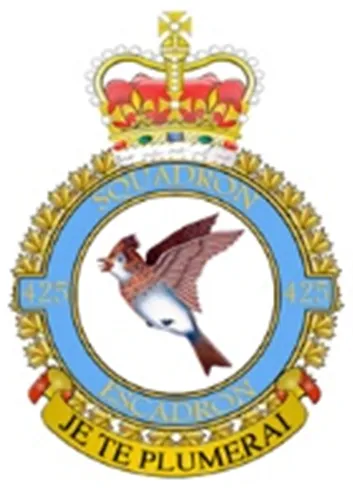
![]() on June 25, 1942 as the RCAF's twenty-second squadron, and fifth bomber squadron, to be formed overseas in WWII. At the time it was part of No 4 Group, RAF Bomber Command. It was unique in being designated "French-Canadian" and every effort was made to find French Canadian airmen elsewhere in Bomber Command who could be transferred to the squadron. It became operational in October, 1942, flying Wellington Mk III aircraft with the squadron code letters KW. It transferred to No 6 (RCAF) Group, Bomber Command when that was formed on January 1, 1943, although remaining at Dishforth. In March, the squadron re-equipped with Wellington X's and from June to October operated from bases in Tunisia (Kairouan/Zina
on June 25, 1942 as the RCAF's twenty-second squadron, and fifth bomber squadron, to be formed overseas in WWII. At the time it was part of No 4 Group, RAF Bomber Command. It was unique in being designated "French-Canadian" and every effort was made to find French Canadian airmen elsewhere in Bomber Command who could be transferred to the squadron. It became operational in October, 1942, flying Wellington Mk III aircraft with the squadron code letters KW. It transferred to No 6 (RCAF) Group, Bomber Command when that was formed on January 1, 1943, although remaining at Dishforth. In March, the squadron re-equipped with Wellington X's and from June to October operated from bases in Tunisia (Kairouan/Zina ![]() and Hani East
and Hani East ![]() airfields) in support of the Allied invasions of Sicily and Italy. In November 1943 the squadron returned briefly to Dishforth and re-equipped with Halifax III aircraft before moving to Tholthorpe, Yorkshire
airfields) in support of the Allied invasions of Sicily and Italy. In November 1943 the squadron returned briefly to Dishforth and re-equipped with Halifax III aircraft before moving to Tholthorpe, Yorkshire ![]() in December, as part of No 62 (RCAF) Base of 6 Group. It remained at Tholthorpe until the end of the war in Europe. In May and June of 1945 it re-equipped with Lancaster X aircraft, in preparation for joining the Tiger Force for attacks on Japan. The surrender of Japan caused the disbandment of the Squadron at Debert, Nova Scotia
in December, as part of No 62 (RCAF) Base of 6 Group. It remained at Tholthorpe until the end of the war in Europe. In May and June of 1945 it re-equipped with Lancaster X aircraft, in preparation for joining the Tiger Force for attacks on Japan. The surrender of Japan caused the disbandment of the Squadron at Debert, Nova Scotia ![]() , on September 5, 1945.
, on September 5, 1945.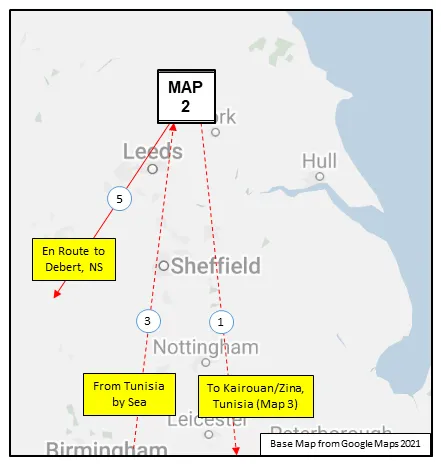
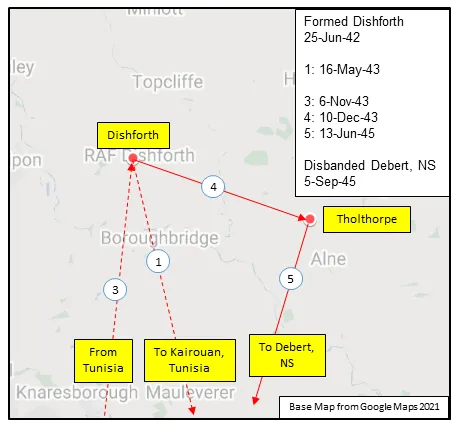
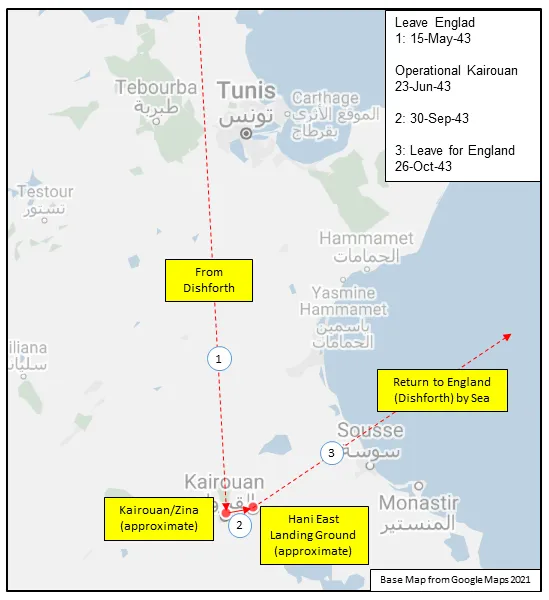
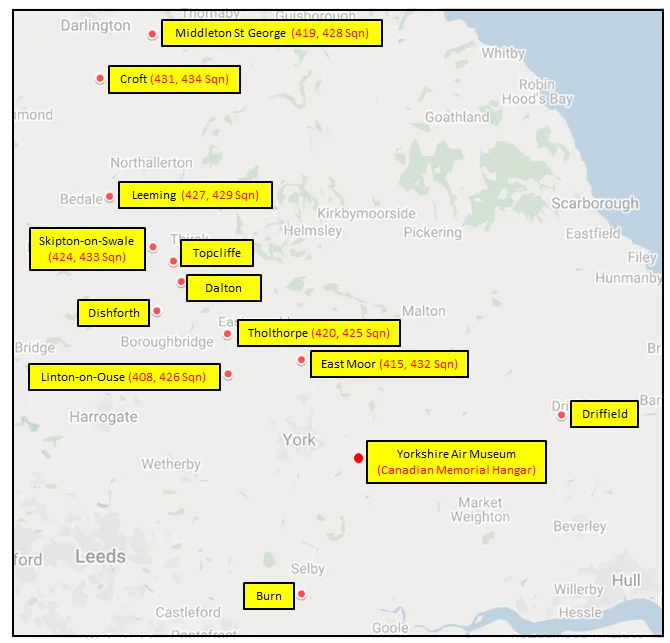
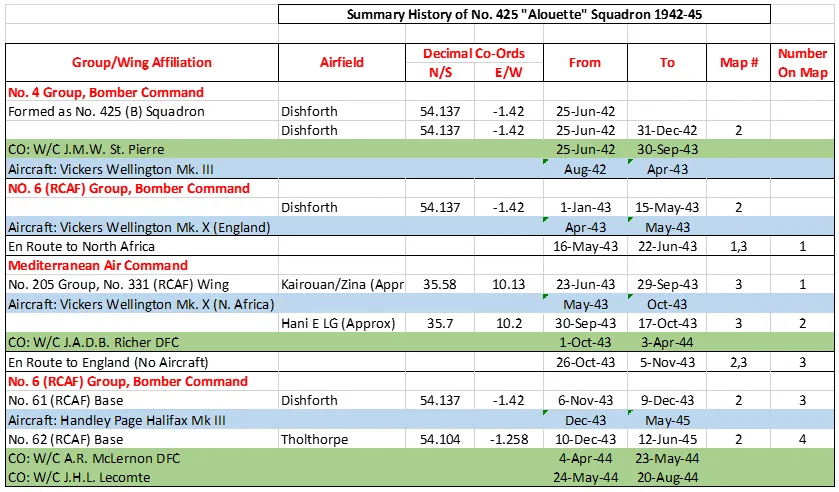

![]() on 1 October 1954. It flew CF-100 Canuck aircraft on North American air defence. Selected as one of five units to be re-equipped with CF-101 (Voodoo) aircraft, it was deactivated on 1 May 1961 pending delivery of the aircraft. Reactivated at Namao (Edmonton), Alberta
on 1 October 1954. It flew CF-100 Canuck aircraft on North American air defence. Selected as one of five units to be re-equipped with CF-101 (Voodoo) aircraft, it was deactivated on 1 May 1961 pending delivery of the aircraft. Reactivated at Namao (Edmonton), Alberta ![]() on 15 October 1961, the squadron initially received the trainer version of the CF-101 and served as a training unit to convert the remaining four squadrons to this aircraft. It afterwards moved to Bagotville, Quebec,
on 15 October 1961, the squadron initially received the trainer version of the CF-101 and served as a training unit to convert the remaining four squadrons to this aircraft. It afterwards moved to Bagotville, Quebec, ![]() in July 1962, and was declared operational on 1 October when No. 3 All-Weather (Fighter) Operational Training Unit assumed responsibility for all future CF-101 training. On 1 February 1968 the squadron was integrated into the Canadian Armed Forces. From 1982, the Canadian Forces started to acquire CF-18 Hornets; 425 Sqn received them in 1985. In 2005, 433 Squadron was merged into 425 Squadron. 425 Tactical Fighter Squadron is an integral part of NORAD and of the North Atlantic Treaty Organization (NATO). In peacetime, the squadron's fighters provide continuous surveillance of the East Coast of Canada. In addition, it must be ready for rapid deployment anywhere in the world in support of NATO or contingency operations.Wikipedia, Kostenuk & Griffin, and www.canada.ca/en/air-force/corporate/squadrons/425-squadron.html
in July 1962, and was declared operational on 1 October when No. 3 All-Weather (Fighter) Operational Training Unit assumed responsibility for all future CF-101 training. On 1 February 1968 the squadron was integrated into the Canadian Armed Forces. From 1982, the Canadian Forces started to acquire CF-18 Hornets; 425 Sqn received them in 1985. In 2005, 433 Squadron was merged into 425 Squadron. 425 Tactical Fighter Squadron is an integral part of NORAD and of the North Atlantic Treaty Organization (NATO). In peacetime, the squadron's fighters provide continuous surveillance of the East Coast of Canada. In addition, it must be ready for rapid deployment anywhere in the world in support of NATO or contingency operations.Wikipedia, Kostenuk & Griffin, and www.canada.ca/en/air-force/corporate/squadrons/425-squadron.html 





